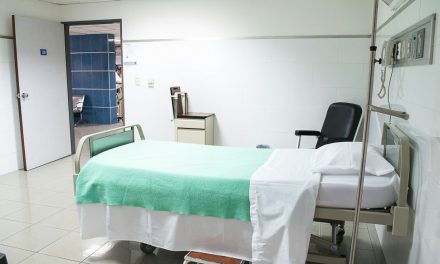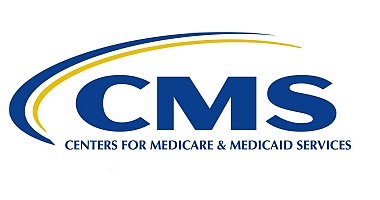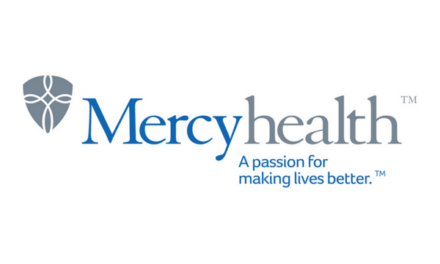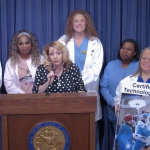
UIC’s Dr. Linda Forst on new center to aid health and well-being of farmworkers
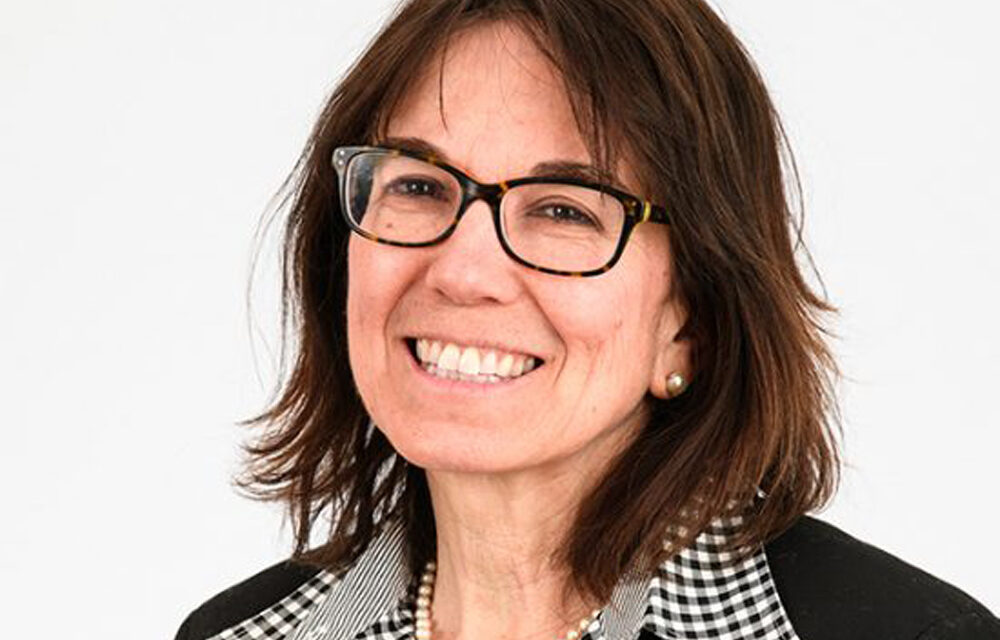
The University of Illinois Chicago announced earlier this month that it will establish a federal center within its School of Public Health focused on the health and safety of farmworkers.
The center, funded with $6 million from the National Institute for Occupational Safety and Health, stands apart from the existing 10 agricultural safety and health centers across the country due to its broader focus on supporting the population, said Dr. Linda Forst, a UIC professor who will serve as its director.
“They’re certainly essential to the health and well-being of all of us in Illinois and across the country,” Forst recently told Health News Illinois about farmworkers. “They’re an integral part of the food supply chain. And I consider them a precious resource that needs to be protected.”
An estimated 30,000 to 50,000 farmworkers are in Illinois.
Forst spoke on the partnerships to make the center a reality, the challenges facing farmworkers and improving the “well-being” of the population.
Edited excerpts below:
HNI: How did this project come to be?
LF: Illinois is a huge agricultural state, and we have a program on agricultural safety and health training that’s also funded by NIOSH that we work on collaboratively between UIC’s School of Public Health and (University of Illinois Urbana-Champaign) folks in the (agriculture) school there, so we have a connection there. And I’ve done work out of UIC’s School of Public Health related to farmworkers’ health. So Illinois has between 30,000 and 50,000 farmworkers in the state that are hired seasonally in the summertime to do agricultural work. So we have a big population of farmworkers in the state. The agriculture sector has the highest rate of work-related fatalities and severe injuries. And farmworkers do manual labor, hired migrant and seasonal farmworkers do manual labor, and so they’re at very high risk for injury and illness at work. And they also have a lot of other economic and social and immigration challenges that increase their risk of injury and ill health. And so we have been doing work with farmworkers and with organizations that reach out to farmworkers for a long time. So we’re collaborating with Legal Aid Chicago and with Community Health Partnership of Illinois, which is a six-clinic network that reaches out to farmworkers, and we’ve been collaborating with them on other projects related to farmworkers for a long time. So it made sense to come together for this funding opportunity and write this grant together.
HNI: What type of farmworkers are you looking at helping with this center?
LF: There are what I think of as three different groups of farmworkers. There are the migrants that most people think about when they’re talking about farmworkers. There are people that live in the southern United States … and they work there during the winter and then in the spring. When the agricultural season ends down there, they start migrating northward with the season. So they get to Illinois in June, and they stay in Illinois until October, when our season ends and it’s too cold to do agriculture in the state. So that’s one group, but that’s a pretty small percentage of farmworkers. It’s only about 5 percent or maybe less.
The majority of farmworkers is another group, which is people that are settled in the state of Illinois. They live in rural areas. They shift back and forth into agriculture in the summertime and then they do other work, manufacturing, transportation, warehousing, whatever, during the cold season. So that’s by far the biggest group, that’s probably 80 percent of who does seasonal farm work.
The third group is H-2A visa holders. So those are workers that obtain a work visa. Farmers and farm owners apply for H-2A visas, and they bring farmworkers to Illinois to do farm work for a finite period. They’re here on a work visa, and there are probably 2,000 to 3,000 of those people in the state each summer.
HNI: How is this center different from the work that’s already being done around farmworkers?
LF: The other 10 Agricultural Safety and Health Centers, they’re in other states, and every center has limited coverage. It’s limited by the number of people and outreach they can do, but most of them address the prevention of work-related injuries in agriculture in their state or in their region. But this center is particularly focused on farmworkers, on the working population that’s most at risk. So the other centers, some of them have individual projects, perhaps, that relate to farmworkers. But our center as a whole is really focused on protecting the health and well-being of farmworkers, of hired migrant and seasonal farmworkers.
HNI: What are the challenges that face farmworkers here in Illinois and across the country?
LF: You can imagine how different the challenges are for those three groups. They all work in agriculture, so they all are exposed to workplace hazards of agriculture. They’re doing heavy physical labor. The temperature can be hot. They have very long work hours. They work in pastures, so they can have ergonomic issues and musculoskeletal injuries because of that. They also work with machinery. There are pesticides around them, so they can be exposed to pesticides. They can get caught in machinery or hurt by machinery. They can fall from heights depending on the kind of work that they’re doing. So those are the kinds of injuries that they experience. And all of them, I would say, could experience any of that equally.
But the challenges that they have are different. People who are migrating from south to north don’t have a home to live in while they’re doing agricultural work. So there are all sorts of makeshift housing that happen for them. That’s less of a problem for H-2A workers. H-2A workers have to have housing provided by them. But the housing isn’t always very good housing, with lots of people in a small space. They share transportation back and forth to the fields.
For a lot of farmworkers, probably in all three groups, it’s crew leaders that are supervising them while they’re working. And so they often don’t even know who the main employer is. They have a go-between person that they relay it to. The wages are across the board, so there are a lot of cash economy workers in this work that are paid off the books. And the work itself is often like piecework, so they’re paid by the pound and not by the hour. There’s a disincentive for them to take a break, go to the bathroom, get a drink of water. So that can be problematic. They often don’t have employment benefits, so they have no paid sick leave. They don’t have health insurance. And so that can be a big impediment for them.
And then they live literally and often in makeshift housing, and so they don’t have access to social services the way others do. They don’t have access to clinics. They live remotely. And then there are cultural and linguistic issues. So most are Spanish speaking. Those that live in Illinois are possibly bilingual, but those who are migrating and those who are H-2A workers are not likely to speak good English, if at all. So there can be a problem.
HNI: There seems to be a growing focus on the social determinants of health for this population. Why is it so important to look at more than just health?
LF: There’s a growing awareness of the fact that health is not only about freedom from disease. So we’re not only trying to treat or prevent diabetes and heart disease. People’s ability to live long and healthy and productive lives is now considered more important, more holistic. So the approach is to address well-being, that people’s well-being includes their health, but it includes how they feel about themselves, their coworkers, other people in society and how well they get along in the world. And so this center focuses more on issues other than specific health conditions or to prevent certain health conditions. Preventing injuries and illnesses while working is important, and preventing hazardous exposure to chemical agents at work are also important. But people have to live day to day. They have to have social networks and connections with other people and institutions to live healthy and happy lives. And so we’re interested in understanding that better and promoting well-being.
HNI: How does the partnership with Legal Aid Chicago and the Community Health Partnership of Illinois work to support the center’s work?
LF: Legal Aid Chicago and Community Health Partnership are integral components of the center, as is the (University of Illinois) Extension. Legal Aid Chicago has been doing work to reach out to H-2A workers for a very long time, so they have a whole unit set up that drives around the state, meets up with H-2A workers and provides information, connects them with resources about both fair employment rights and workplace health and safety. So Legal Aid Chicago is part of the internal group of the project and we’ll be doing those activities on behalf of the project going forward.
Community Health Partnership of Illinois has been in existence since 1970, and it started out as a migrant clinic. So there was a program set up for them specifically to reach out to migrant and seasonal workers from the beginning. And over time, they turned into a federally qualified health center network, and they connect farmworkers with health and healthcare resources. They have six clinics around the state, and they also have a mobile van, so they do outreach to farmworkers on various topics. And so our connection with them gives this whole program greater connection and access to farmworkers in the field.
And then UI Extension also does a lot of community-based outreach around nutrition and various agricultural issues. And so their connections to rural communities are also important. Those three provide an integral connection to the community and pathways to reaching the community, as well as expertise themselves to contribute to the whole program.
HNI: What’s the timeline for getting the center set up?
LF: At the moment, we’re preparing all the documents and all that, everything to stand up the center. We have our kickoff meeting in a couple of weeks where all of the internal partners, so that’s faculty and staff from UIC and UIUC, as well as Legal Aid Chicago, Community Health Partnership of Illinois and UI Extension, will come together. We’re also working with the Illinois Department of Public Health, the Illinois Department of Labor, Illinois Department of Employment Securities, who have a big role in working with farmworkers and ensuring all the legal and health aspects of their work. And they’ll come together as well, and we’ll do planning for outreach to the groups. We also have two research projects that are funded within the center.
One research project is to develop a survey that is validated for use in farmworkers around health and well-being. So we’re working on survey design and evaluation, and we’re adapting a NIOSH well-being survey for this workforce specifically. So that’s one research project that will go on for three years.
A second research project is to try to develop a public health surveillance program for these workers. And so to try to figure out where everybody is, who they are, where they work, what their needs are, their workplace hazards, and to develop a surveillance system for work-related illnesses and injuries in the state. And so that’s a second research project.
And then third, we’re also doing a pesticide project related to preventing pesticide exposure among this group. So the idea is to prevent acute pesticide poisoning, but also chronic effects of chronic, adverse health effects of pesticide exposure.





